It’s time! April is roaring along. Sunshine and stout, cool breezes outside; kitchen pinging inside with this month’s can jam ingredient: Herbs!
Bebop-a-rebop-a-rhubarb pie
Garrison Keillor inspired me to stake claim to my Minnesotan heritage with the stalk-y pink rods fondly jingled in his show, A Prairie Home Companion: Rhubarb! (otherwise, it’d be ketchup…hmm…herb ketchup actually sounds good.)
I wasn’t sure what to make with this sourpatch, celery-like veggie-fruit (rhubarb), since I can’t say I’d ever tried it. And then, which flavor compliments? Fresh herbs or dried, edible flowers? A major tasting session was in order.
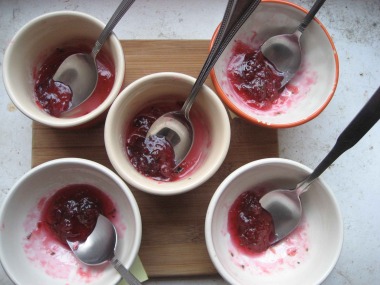 get your tastebuds ready, super-small batches
get your tastebuds ready, super-small batches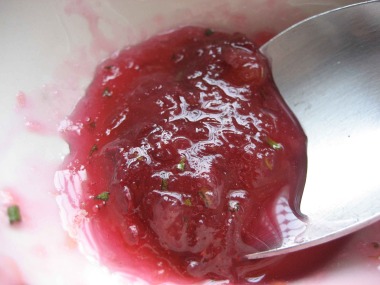 sweet research
sweet research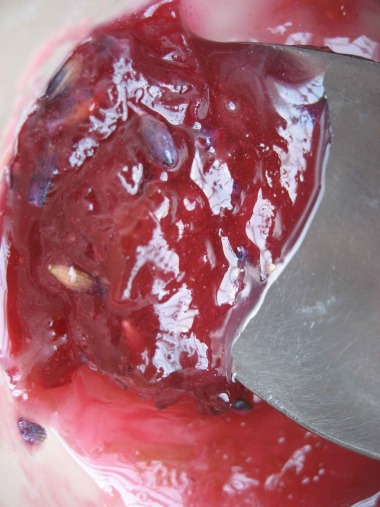 the pretty (but weird tasting) award goes to…Lavender
the pretty (but weird tasting) award goes to…Lavender
This tasting experiment brought two things to my attention:
1. It is so ridiculously easy to make a tiny batch of preserves/jam for immediate consumption (within a couple weeks). What a great idea if you don’t have a ton of fruit, don’t feel like pulling out the canner and jars or have just enough time to impress your teatime guests with a just-made spread. I used one stalk of rhubarb (and adjusted, small proportions of rest of ingredients, below) and parceled the mixture into 5 cups with different herbs/flowers awaiting tasting.
2. I don’t think anyone wants to eat actual lavender buds; they’re better contained in underwear drawer sachets. However, a lavender syrup (from an infusion) might be a fun afternoon experiment.
Verdict
Alas, out of sheer indecision, I did two different batches. I couldn’t decide which I liked more from my taste-testing. So, hell, I made both. My friend Julia, of What Julia Ate, granted me a Jam Ninja name: Double-batch Kick-ass. What dub’est thou for thine own Jam Ninja name?!
Okay, let’s get on with it, recipes for your own rhubarb business:
I modified (and halved) Linda Ziedrich’s Rhubarb-Rose Preserves recipe from The Joy of Jams, Jellies & Other Sweet Preserves (my new fave book, by the way, cheers to the Tigress for turning me onto her rogue/practical style.) In this book I read about how rhubarb is a high acid ‘fruit’ (it’s technically a vegetable) and thus felt safe swapping herbs/dried flowers in place of the rose petals.
Rhubarb Sage Preserves
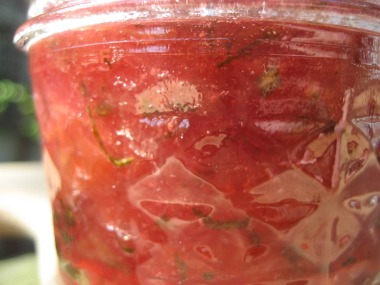 Contestant #1: rhubarb sage preserves1lb rhubarb (about 2-1/2 cups), sliced in 1/2 inch cross sections
Contestant #1: rhubarb sage preserves1lb rhubarb (about 2-1/2 cups), sliced in 1/2 inch cross sections
1-1/2 cups sugar
1 tablespoon strained lemon juice
about 6 or 7 sage leaves, minced finely
Method: Cut rhubarb and combine with sugar to sit overnight in a heavy-bottomed pot or for at least 6 hours. After most of the sugar has dissolved, add lemon juice and sage and heat mixture over medium heat. Stir to keep sugar from scorching the bottom of the pan. It will take about 10 minutes for the mixture to thicken up. Remove pan from heat and let it sit for 5 minutes before ladling it into hot jars. Process for 15 minutes in waterbath canner.
Rhubarb Hibiscus Preserves contestant #2: hibiscus rhubarb preserves
contestant #2: hibiscus rhubarb preserves
I think you could do the hibiscus a couple different ways. I toyed with making a hibiscus water, and dropping in pieces of the re-constituted flowers for flare; but when I munched on the tasting sample, which had pieces of pseudo-reconstituted flowers, I didn’t mind the texture. I opted to chop the dried flowers up as finely as I could, and throw them in to reconstitute while the preserves cooked.
1lb rhubarb (about 2-1/2 cups), sliced in 1/2 inch cross sections
1-1/2 cups sugar
1 tablespoon strained lemon juice
approx 1/3 cup dried whole hibiscus flowers, chopped finely
Method: same as above
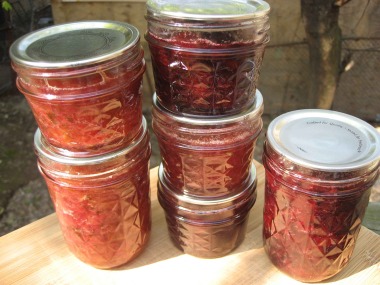 The official run-down? Two hours morning labor, an extremely low-stress method and definitely my most successful sweets preserving thus far…I’ll count this as a win.
The official run-down? Two hours morning labor, an extremely low-stress method and definitely my most successful sweets preserving thus far…I’ll count this as a win.

